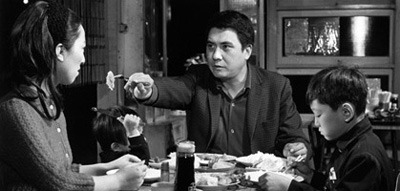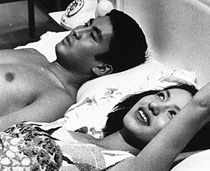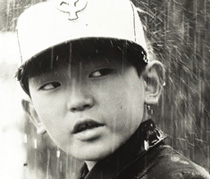 Over the years, many a Japanese filmmaker has captured my attention, becoming the object of a protracted obsession: Akira Kurosawa, Masaki Kobayashi, Beat Takeshi, Kenji Misumi, Yasuzo Masumura, Kenji Mizoguchi, Hideo Gosha, Kazuo Ikehiro, and on and on. Nagisa Oshima, however, was never one of them. I don't know why, the guy just never got under my skin. I liked Cruel Story of Youth, Realm of Passion and Taboo. The Realm of the Senses was alright. Didn't care for Merry Christmas, Mr. Lawrence. Hated Violence at Noon. And yet, he is one of the Big Names, so in light of the recent Criterion box (Oshima's Outlaw Sixties), as well as a couple of suggestions from Peter Nellhaus, I decided to delve deeper into this filmmaker's oeuvre. Here's what I've come up with so far.
Over the years, many a Japanese filmmaker has captured my attention, becoming the object of a protracted obsession: Akira Kurosawa, Masaki Kobayashi, Beat Takeshi, Kenji Misumi, Yasuzo Masumura, Kenji Mizoguchi, Hideo Gosha, Kazuo Ikehiro, and on and on. Nagisa Oshima, however, was never one of them. I don't know why, the guy just never got under my skin. I liked Cruel Story of Youth, Realm of Passion and Taboo. The Realm of the Senses was alright. Didn't care for Merry Christmas, Mr. Lawrence. Hated Violence at Noon. And yet, he is one of the Big Names, so in light of the recent Criterion box (Oshima's Outlaw Sixties), as well as a couple of suggestions from Peter Nellhaus, I decided to delve deeper into this filmmaker's oeuvre. Here's what I've come up with so far.Pleasures of the Flesh (1965)
 I really enjoyed this weird tale of a slightly insane young man who murders for love (unrequited), then is blackmailed into holding a small fortune for a crooked government official (just until the old guy gets out of prison). The young man, played compellingly by Katsuo (brother of Kinnosuke) Nakamura, decides fuck it, and uses the money to create a living fantasy of luxury and non-stop sex. Of course, this extended spree takes its toll, the man growing jaded and cruel. According to Audie Bock, the young man symbolizes Japan, newly rich and without a moral compass. (Oshima utilized symbolism quite a bit in his mid to late 60s films as we shall see.) I appreciated this careful-what-you-wish-for-you-might-get-it parable and found the plot and pace right on the money (not always a given with Oshima). So I give this one a thumbs up.
I really enjoyed this weird tale of a slightly insane young man who murders for love (unrequited), then is blackmailed into holding a small fortune for a crooked government official (just until the old guy gets out of prison). The young man, played compellingly by Katsuo (brother of Kinnosuke) Nakamura, decides fuck it, and uses the money to create a living fantasy of luxury and non-stop sex. Of course, this extended spree takes its toll, the man growing jaded and cruel. According to Audie Bock, the young man symbolizes Japan, newly rich and without a moral compass. (Oshima utilized symbolism quite a bit in his mid to late 60s films as we shall see.) I appreciated this careful-what-you-wish-for-you-might-get-it parable and found the plot and pace right on the money (not always a given with Oshima). So I give this one a thumbs up.A Treatise on Japanese Bawdy Songs (1967)
 Criterion is using the alternative title Sing a Song of Sex, but that title is misleading. This isn't some light-hearted sex romp, but rather a somewhat dry tale of four male high school graduates and the perverse directions in which their misguided energies take them. Issues touched upon include rape fantasies (which may or may not come true), the death of a teacher (who may or may not have been murdered), peace rallies, an obsession with an older woman and, of course, singing. Lots of singing. If it isn't the incessant repetition of one particular Japanese bawdy song by the boys, it's folk songs, drinking songs, even a little Korean prostitute ditty evoking a motif common to several Oshima films of the period, that of Korean identity in post-war Japan. Also present is Oshima's singular flag imagery. This time out it's an alternative Japanese flag, with a black dot instead of a red one, symbolizing Oshima's regard for Japan as a dead nation (the black dot flag and Japan's treatment of Koreans is also featured prominently in Oshima's Death by Hanging). Too bad A Treatise on Japanese Bawdy Songs unravels so badly in the third act. Either Oshima lost interest, or he decided to drive us all crazy -- this also happens in films of this period (see Violence at Noon). Worth a look if you're interested in Japan of the late 60s, but I couldn't really recommend it otherwise.
Criterion is using the alternative title Sing a Song of Sex, but that title is misleading. This isn't some light-hearted sex romp, but rather a somewhat dry tale of four male high school graduates and the perverse directions in which their misguided energies take them. Issues touched upon include rape fantasies (which may or may not come true), the death of a teacher (who may or may not have been murdered), peace rallies, an obsession with an older woman and, of course, singing. Lots of singing. If it isn't the incessant repetition of one particular Japanese bawdy song by the boys, it's folk songs, drinking songs, even a little Korean prostitute ditty evoking a motif common to several Oshima films of the period, that of Korean identity in post-war Japan. Also present is Oshima's singular flag imagery. This time out it's an alternative Japanese flag, with a black dot instead of a red one, symbolizing Oshima's regard for Japan as a dead nation (the black dot flag and Japan's treatment of Koreans is also featured prominently in Oshima's Death by Hanging). Too bad A Treatise on Japanese Bawdy Songs unravels so badly in the third act. Either Oshima lost interest, or he decided to drive us all crazy -- this also happens in films of this period (see Violence at Noon). Worth a look if you're interested in Japan of the late 60s, but I couldn't really recommend it otherwise.Boy (1969)
 Based on real events, it's the story of an incredibly dysfunctional family of con artists who fake being hit by automobiles to extort money from the distraught drivers. Fumio Watanabe, one of Oshima's go-to actors, turns in another great performance as a truly despicable man, the father who forces his wife and young son to run out in traffic, risking their lives for payoffs so he can lounge around in hotels and eat. Oh, the eating. This guy is always eating. (Watanabe, in the photo up top, was a versatile actor with a bulbous nose, perhaps the Karl Malden of Japanese cinema? In the 70s he moved to Toei where he played heavies in such exploitation classics as Joy of Torture and Convent of the Sacred Beast.) Oshima's flag imagery is in full force here; this time, it's the standard Japanese flag, always in close proximity to the family, making me suspect it symbolizes some aspect of Japanese society with which the filmmaker has an issue (lassitude? Gluttony? Mistreatment of the young?). Bottom line: Awesome film, the best I've seen from Oshima and one that is rightly singled out as a classic. Young Tetsuo Abe, playing the eponymous 10-year-old, gives a devastating performance as the tough little guy who endures painful injuries, a life of uncertainty and all his father's cruelty and manipulation. This is the film Criterion should release.
Based on real events, it's the story of an incredibly dysfunctional family of con artists who fake being hit by automobiles to extort money from the distraught drivers. Fumio Watanabe, one of Oshima's go-to actors, turns in another great performance as a truly despicable man, the father who forces his wife and young son to run out in traffic, risking their lives for payoffs so he can lounge around in hotels and eat. Oh, the eating. This guy is always eating. (Watanabe, in the photo up top, was a versatile actor with a bulbous nose, perhaps the Karl Malden of Japanese cinema? In the 70s he moved to Toei where he played heavies in such exploitation classics as Joy of Torture and Convent of the Sacred Beast.) Oshima's flag imagery is in full force here; this time, it's the standard Japanese flag, always in close proximity to the family, making me suspect it symbolizes some aspect of Japanese society with which the filmmaker has an issue (lassitude? Gluttony? Mistreatment of the young?). Bottom line: Awesome film, the best I've seen from Oshima and one that is rightly singled out as a classic. Young Tetsuo Abe, playing the eponymous 10-year-old, gives a devastating performance as the tough little guy who endures painful injuries, a life of uncertainty and all his father's cruelty and manipulation. This is the film Criterion should release.


3 comments:
I saw the Oshima retrospective when it came to town a few years ago, and at first I was confused to say the least. But after a few of the films, I think I started to get Oshima and now I hold him as one of the top 4 or 5 Japanese directors. It's nice to finally see some of his work coming out on DVD in the USA.
Many compare him to Imamura ("Japanese New Wave"-whatever that means), but I much prefer Oshima's style and pacing.
Anyway, well worth it to search out his films; might not make a whole lot of sense right away, but the payoff is worth it.
Thanks for the mention. For myself, the more I see of Oshima, the more I find myself thinking that perhaps not every film was a masterpiece, or even worth seeing. The other problem to me is that so many of the films by his peers are unknown and often unavailable on English subtitled DVD. There is a distorted sense of Japanese film history when one depends on the Criterion Collection.
Quite agree with you about "Pleasures of the Flesh," P.G. I especially enjoyed the plot twists at the end. We'll have to see how things go as I work my way through the rest of the "Outlaw Sixties" box set.
Post a Comment